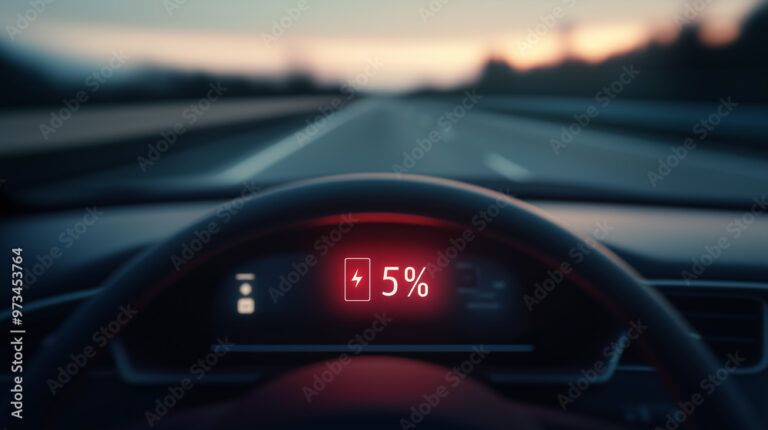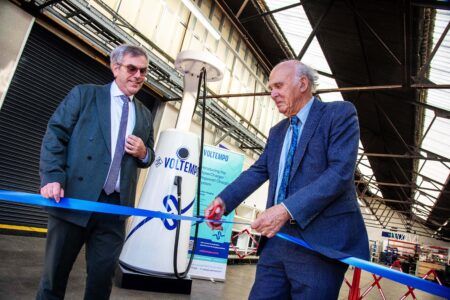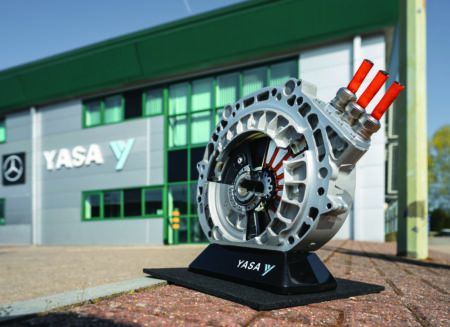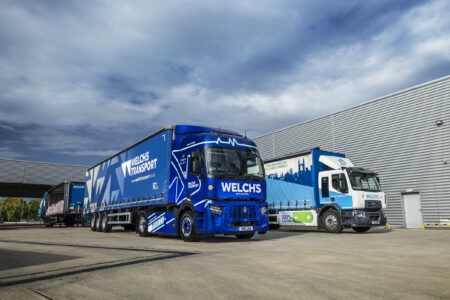Range anxiety was once seen as a major barrier to EV ownership, but with the rapid progress of technology, the concept has become outdated to the point of near obsoletion.
In simple terms, range anxiety is the fear that an EV will run out of charge before you can find a charging point or before you reach your destination, and its origins are easy to understand.
In 2010, the Nissan Leaf went on sale, becoming the first modern, mass-market EV. While it represented a huge leap in EV technology compared to what had come before, the limitations of these early EVs are clear to see, with the 2011/12 Leaf’s US EPA range given as 73 miles from its 24 kW/h battery. In 2011, the US Department of Energy stated that there were 5070 EV charging points in the US, located across 2100 station locations, compared with 157,393 gas stations, according to the trade publication National Petroleum News. Knowing this, it’s easy to see where range anxiety stems from. Even as recently as 2022, range anxiety was still a major barrier to EV ownership, with a survey by AAA showing that 58% of respondents cited it as the reason for not considering an electric car.
Technology has been progressing rapidly, however. The first Tesla Model S arrived in 2012, with a range of over 208 miles for the entry-level model, while today, the average modern EV range is approximately 300 miles.
Furthermore, while achievable range is seen as an important factor, it contrasts sharply with the actual needs of average motorists, meaning range anxiety is more a psychological factor than a real-world issue. In the US, the average daily driving distance is 37 miles while the average daily commuting distance is about 20 miles, meaning every EV currently on sale would effortlessly meet the daily driving demands of the average motorist.
Battery technology breakthroughs
Range anxiety has steadily become much less of an issue thanks to the constant and rapid improvements in battery technology, specifically energy density, cell chemistry innovations and advancements in battery management systems.
Battery energy density, which refers to the amount of energy a battery can store in relation to its weight, has seen constant and significant increases. In 2010, the average battery energy density was around 100 Wh/kg, whereas in 2025, we have Panasonic’s 260 Wh/kg NCA Lithium-Ion battery technology, with its 2170 cells powering Tesla’s Model 3. Meanwhile, Amprius Technologies’ Lithium-Silicon Anode battery has reached commercial viability and delivers an energy density of 500 Wh/kg.
Battery cell chemistry innovations have been instrumental in increasing energy density and significantly decreasing charge times. BYD’s blade battery has singular cells that are arranged together in an array and then inserted into a battery pack. Due to its optimised battery pack structure, the battery pack is 50% smaller than conventional LFP packs, is extremely safe, and delivers 190 Wh/kg. “In terms of battery safety and energy density, BYD’s Blade Battery has obvious advantages,” said Professor Ouyang Minggao, Member of the Chinese Academy of Sciences and Professor at Tsinghua University.
Samsung SDI’s solid-state battery, which the company is planning to begin mass-manufacturing in 2027, has an energy density exceeding 500 Wh/kg and, in prototype testing, has delivered 500 miles of range. Then there is QuantumScape’s solid-state battery technology, with a 301 Wh/kg energy density that delivers blistering charging speeds. Frank Blome, CEO of VW Group’s PowerCo battery cells subsidiary and a board member at QuantumScape, said: “Solid-state batteries will be able to charge to the 80% capacity in as little as 12 minutes.”
In April of 2025, CATL announced its Freevoy Dual Power Battery, delivering over 900 miles of range, as well as its new Shenxing battery, which can charge to 320 miles of range in just five minutes and has a full battery capacity of 500 miles. “Once again, we are pushing the boundaries of performance beyond limits,” CATL’s Chief Technology Officer Gao Huan said. “Our goal is to make the CATL Shenxing supercharging battery the standard for electric vehicles,” he added.
In addition to this, advancements in battery management systems have helped prolong battery life. For example, General Motors’ advanced BMS serves to extend both range and battery life, while LG Energy Solution’s smart cell monitoring tracks and manages the performance of individual battery cells within a larger battery pack, continuously monitoring key parameters like voltage, current, temperature, and state of charge for each cell within a battery pack to ensure safety and optimal performance.
More recently, a research team from Pohang University of Science and Technology in Korea looked at how adding a multi-walled carbon nanotube on the surface of battery electrodes would impact battery life. Their findings showed that doing so prevented cracks from appearing within the battery, which is caused by the charging process, resulting in a decline in battery performance over time. By applying the carbon nanotube technology, researchers found that the batteries tested retained about 78% of their initial capacity after 1000 charge and discharge cycles.

Charging infrastructure expansion
While the rapid and significant improvements in battery technology have played a large part in reducing range anxiety, charging infrastructure has seen huge development over the past 10 years.
First and foremost, there’s the sheer growth in the global charging network. According to research by Statista, in 2016, there were 200,000 charging stations worldwide, whereas, in 2025, that figure stands at approximately 3 million, with projections estimating there to be 3.32 million stations operational by 2028. A 2024 study by Juniper Research predicted the total number of EV charging points globally will grow by 194%, rising from 21.8 million to 64 million by 2029.
Beyond the increase in charger availability, advances in charging speed have made charging stops much shorter and less of an inconvenience. In 2018, 50 kW was the standard, with a 10-80% charge taking an hour or more. By 2021, 150 kW chargers had become common, cutting charging times to around 30 minutes. In 2024, 350 kW chargers became available, reducing charging times to between 15 and 20 minutes, and global coverage of ultra-rapid charging points is now extremely extensive. ABB has its Terra HP chargers delivering up to 350 kW; Electrify America has its 350-kW highway network with more than 950 stations and over 4250 DC fast charging connectors as of August 2024. Furthermore, there is a push to upgrade charging stations to 500 kW, particularly in the United States, reducing charging times to as little as 12 minutes. Chargepoint offers its Express Plus Power Link 2000 charging stations, Nio its Nio Day 22 charging pile, while in 2024 Gravity opened its Manhattan-based EV charging centre with 24 500 kW charging points.
In Europe, Ionity is aiming to have 7000 350 kW chargers in place in 2025 and has just announced that it will be the first European charge point operator to procure the newly unveiled HYC1000 megawatt chargers from Alpitronic for its network. These will allow up to eight vehicles to charge per charge point or single vehicle charging at up to 600 kW, allowing compatible cars to reach up to 300km of range in under eight minutes. “By integrating the HYC1000 chargers, we’re giving our customers access to some of the fastest and most advanced charging technology available today,” said Jeroen van Tilburg, CEO of Ionity.
Recently, BYD unveiled its fastest charging technology, to date. Lian Yubo, Executive Vice President of BYD and President of the Automotive Engineering Research Institute, stated: “BYD has self-developed the world’s first all-liquid-cooled Megawatt Flash Charging terminal system, with a maximum output capacity of up to 1360 kW. Additionally, BYD’s unique ‘dual-gun charging’ technology can instantly transform existing supercharging piles into flash charging ones, and fast charging piles into supercharging ones.”
Beyond that, there have been significant EV charger coverage improvements across the globe. In Europe, the top 10 countries have between approximately 1000 and 3500 charge points per 100km of motorway. While the US has only 22 charge ports per 1000 miles of road, the number of total charge points across the States is forecast to rise from about 4 million currently to 35 million in 2030, according to a PwC analysis, which will significantly increase the number of points per 1000 miles to over 190.
In the US, about 60% of urban residents live within a mile of a public EV charger, while across Europe, the top 10 cities exceed one charge bay per square kilometre, with Oslo having 5.47, London 3.17 and Amsterdam 2.24. Additionally, across Europe and the US, on average, 50% of charging by EV owners is done at home, with approximately 1 million home chargers in the UK as of the end of 2024, according to Zap-Map, with 300,000 of those having been installed in 2023, which demonstrates the huge uptake in home charging by EV owners, thanks to the lower charging cost and convenience.
Software and planning solutions
The final element that has played a key role in reducing range anxiety among EV customers is that of advancements in software and planning solutions. This has allowed for much-improved route navigation that plans journeys around charging needs, as well as giving much more accurate range prediction.
In terms of route planning intelligence, modern EVs have built-in navigation systems that will assist you on a journey by planning charging stops along the way and even allowing you to set a desired charge percentage remaining at the end of your trip. Range prediction algorithms have also been constantly improving, which means EV users receive much more accurate range prediction. For example, Tesla has stated that when calculating a route and remaining battery percentage on arrival, the onboard navigation system considers over 20 different factors, including wind speed and direction, elevation and gradient, ambient temperature, and rolling resistance.
There are also third-party apps that are all designed to make travelling by EV much less stressful. For example, PlugShare states that it has the most accurate and complete public charging map worldwide, with a database of over 250,000 stations in the US and more than 450,000 globally. A Better Routeplanner is similarly impressive, optimising routes for EVs, considering factors like charging infrastructure, range, and energy consumption, and even allowing you to connect your EV to the app so it can monitor your battery level as you travel and guide you to chargers. In 2023, Rivian acquired Swedish mapping company Iternio, developer of the ABRP app and uses the software in its cars. RJ Scaringe, Founder and CEO of Rivian, said: “A Better Routeplanner leads the way in EV trip planning and is an important platform for driving EV adoption. Beyond route planning, the data insights on where there is insufficient reliable charging will help us strategically plan where we prioritise building our Rivian Adventure Network.”
The final aspect of this area of improvements to software and planning solutions covers real-time availability and reliability data. Here, constant improvements are being made to network uptime with solid, reliable hardware, regular software updates, and proactive maintenance. Furthermore, real-time charger status reporting provides users with instant information about any chosen charger. This allows them to see whether it’s occupied or available and whether it’s functioning or disabled. It is available across numerous apps, ensuring that when an EV driver arrives at a charger, they know that they will be able to use it.
Current state of range confidence
The continuing advancements in EV technology and infrastructure have been such that range anxiety is no longer a real-world limiting factor in EV ownership. A survey of 1430 EV drivers in the UK conducted by EV.Energy in 2023 showed that 58% of participants are confident in planning long-distance trips, and over 77% of respondents had never, rarely or occasionally experienced concerns about their EV’s range. With the average EV range in 2025 being almost 300 miles, an average long-distance EV journey will require two to three charging stops, with 20-30 minutes now a reasonable amount of time to allow for a reasonable amount of charge per stop.
Numerous recent EV world records highlight just how far both the capabilities of the cars and supporting infrastructure have progressed in order to make them possible. In 2024, Rahul Kakar, from Autocar India, set a new Guinness World Record for the longest journey by an electric car on a single charge, driving a Mercedes-Benz EQS 580 589.68 miles from Bengaluru to Mumbai. That same year, Lexie Alford became the first person to officially lap the globe by EV, covering 30,000 miles in 200 days in a Ford Explorer.
Thanks to these leaps in technology, EV drivers are now expressing high levels of confidence in and satisfaction with their cars. In December 2024, the Global EV Drivers Alliance released the results of the world’s first global survey of EV drivers. With responses from over 23,000 participants in 18 countries, the survey revealed that 92% of EV owners plan to buy another EV for their next vehicle. In a study carried out by Electric Road between 2023 and 2024, 83.1% of 2335 EV owners surveyed stated they were very satisfied with their ownership experience. Furthermore, a 2025 J.D. Power study found that 94% of BEV owners are likely to consider purchasing another BEV for their next vehicle.
While range anxiety has been severely reduced, charging anxiety is still a concern among EV owners, being the worry that chargers might not be functioning, long queues during peak times of demand, as well as software and hardware glitches that cause issues with charging. However, the continuing expansion of EV infrastructure is helping to make these concerns a thing of the past, too, thanks to more chargers and faster charging technology, reducing the likelihood of being faced with non-functioning charging equipment and long wait times.
It’s fascinating to see just how far EVs and their supporting infrastructure have come in the 15 years since the Nissan Leaf first launched, and it’s not unreasonable to say that, in the next 15 years, the global EV network will become unrecognisable. The constant development of and advancements in battery and charging technology, along with the continued expansion of worldwide EV infrastructure means that, even in the next few years, range anxiety will be reduced even further still, and soon, it’s entirely reasonable to expect that it will cease to exist entirely.
